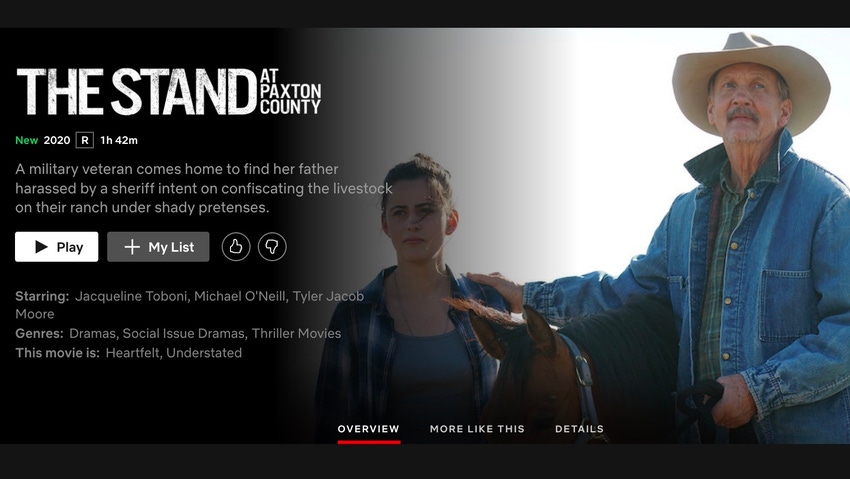Netflix film reveals activists’ tactics to take your ranch
“The Stand At Paxton County” was released on Netflix over the weekend, and the true story is more chilling than the thriller portrayed by Hollywood.
May 4, 2020

Earlier this year, before the world came to a crashing halt due to COVID-19, I attended a movie premier at the Black Hills Stock Show.
Produced by Forrest Films in collaboration with Protect the Harvest, “The Stand At Paxton County” is a thriller that depicts the story of a military veteran who comes home to find her aging father harassed by the local sheriff, who is intent on confiscating the livestock on their ranch under shady pretenses.
Throughout the movie, we discover that animal rights activists have infiltrated and influenced local law enforcement (a common tactic in real life), and the family is forced to fight corruption, lies and, media scandal in an effort to save the ranch, keep their horses, and protect their legacy.
And while the movie is a nail-biter from start to finish (you might even see an appearance of a familiar face — Nebraska rancher Trent Loos), the tragic part of this tale is that it’s based on a true story.
These harrowing events actually took place on a Gladstone, N.D., ranch owned by Gary Dassinger. Gary, along with his daughter, Missy, faced the unthinkable when a hired man staged photos of neglect and abuse and made a report to authorities.
As told by Savanna Simmons for The Fence Post, “A woman who had never been to Gary’s ranch submitted a complaint April 22, 2017, to the Stark County Sheriff Department that his animals were uncared for within the parameters of North Dakota law Title 36, Livestock Chapter 36-21.1. Humane Treatment of Animals. On Monday, North Dakota Southwest District Judge Rhonda Ehlis returned judgement that Gary’s livestock may not be seized, though he will still face a criminal trial to determine whether his animals experienced abuse or neglect.”
The entire story takes you down a long, windy road, where the Dassingers were harassed, intimidated, and manipulated. Protect the Harvest lays out a high-level overview of this case and how it played out:
Measure 5 is an initiated state statute pushed by the Humane Society of the United States (HSUS) and the Humane Society Legislative Fund. It was defeated by the people of North Dakota; however, an amended version became law in 2013.
Law enforcement in North Dakota were trained by HSUS on how to go about seizing animals and the enforcement of this new law.
A disgruntled employee that was not following through with his responsibilities of caring for the livestock was behind the claim of neglect and abuse. Even though his behavior was unethical, he became a witness with immunity.
An out-of-state accuser got involved.
A veterinarian with a grudge and a previous defamation judgment against her to the tune of more than $250,000 was another major player. This veterinarian slandered one of her associates to the entire veterinary community over hearsay.
A sheriff’s department with deputies that have little to no experience with animals, especially livestock, led the charge in evaluating the animals.
A state’s attorney’s office that clearly has no ranching or livestock background enforced the charges.
Ultimately, two independent veterinary assessments proved that the out-of-state claims and the report by the unethical veterinarian were not based on factual observations or science.
Of the case, Protect the Harvest said, “With the help of his daughter Missy, a Major in the Air Force stationed in Japan, Protect The Harvest, and many others, Gary successfully fought to keep his livestock and his 40-year breeding program. However, it was not without great personal sacrifice both emotionally and financially.
“What happened to Dassinger is almost identical to other cases executed by the HSUS. The result of Gary Dassinger’s legal fight is a strong lesson to farmers, ranchers, and animal owners in North Dakota and around the whole country.”
Read more about this case here.
As I mentioned, “The Stand At Paxton County” is based on this true story, and the movie premier in January attracted the media, members of the ranching community, and several elected officials, including South Dakota’s Governor Kristi Noem.
Fast-forward to May 2, and the movie’s official release on Netflix. This is a huge deal as it exposes the tactics of animal rights extremists and wakes up animal owners and private property owners to the real threat of outside parties making wild accusations that you may be forced to fight.
And even if the claims are invalid, the financial burden of clearing your name is court is often the straw that breaks the camel’s back, which works for these groups as well, because you’re no longer operating.
Ask yourself if you know in your state or your county — who defines animal abuse? Who is your sheriff loyal to? Do your law enforcement officials understand animal agriculture? Do they respect and follow the Constitution? If so, were they trained by activists or has the agricultural community served as a trusted resource? What are your private property rights? If observed from the road, what authority do officers have to search your property? What should you say if someone shows up to your ranch wanting to “look around?”
Watch the movie and do a little homework to know what your rights are in your county and state. Thanks to Protect the Harvest for making movies like this happen. These stories must be told to protect ranching families and to inform good-hearted donors about the true intentions of these groups. Check out the movie and let me know what you think!
The opinions of Amanda Radke are not necessarily those of beefmagazine.com or Farm Progress.
About the Author(s)
You May Also Like




.png?width=300&auto=webp&quality=80&disable=upscale)
